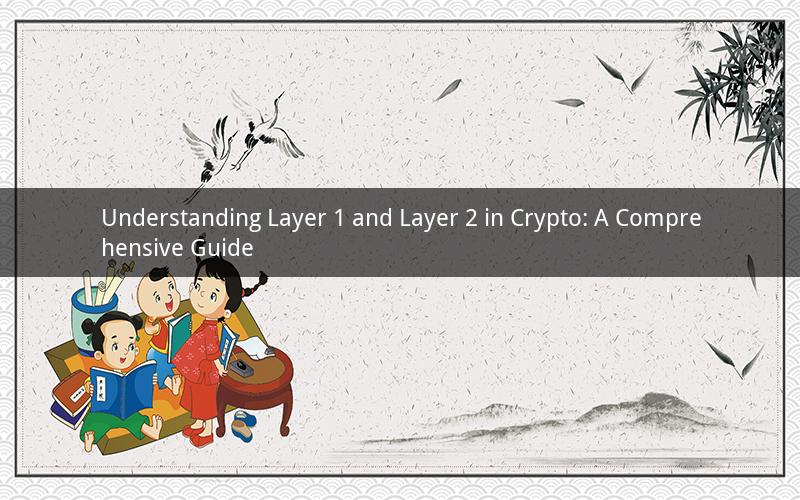
In the world of cryptocurrencies, the terms "Layer 1" and "Layer 2" are often used, but many individuals may not fully comprehend what they mean. This article aims to delve into the essence of these two concepts, providing a thorough understanding of their functions, differences, and implications in the crypto space.
1. What is Layer 1?
Layer 1 refers to the foundational protocol that supports the entire blockchain ecosystem. It is the primary layer of a blockchain network and is responsible for the core functions such as security, consensus, and data storage. Some of the well-known Layer 1 blockchains include Bitcoin (BTC), Ethereum (ETH), and Binance Smart Chain (BSC).
The primary characteristics of Layer 1 are:
1.1 Security: Layer 1 blockchains ensure the security of transactions and data by using cryptographic algorithms. The security level is determined by the complexity of the algorithm, the number of nodes participating in the network, and the overall hash rate of the blockchain.
1.2 Consensus: Layer 1 protocols enable nodes to reach an agreement on the state of the blockchain through consensus mechanisms such as Proof of Work (PoW) or Proof of Stake (PoS). Consensus mechanisms ensure that the blockchain remains secure and reliable.
1.3 Scalability: Layer 1 blockchains aim to handle a large number of transactions efficiently. The scalability of a Layer 1 blockchain is measured by its transaction throughput and the average block time.
1.4 Interoperability: Layer 1 blockchains may support interoperability with other blockchains, allowing for cross-chain transactions and asset exchanges.
2. What is Layer 2?
Layer 2 is an additional layer built on top of a Layer 1 blockchain. It is designed to improve the scalability, reduce costs, and enhance the overall user experience of the underlying Layer 1 network. Layer 2 solutions are often referred to as "sidechains" or "rollups."
The primary characteristics of Layer 2 are:
2.1 Scalability: Layer 2 protocols address the scalability limitations of Layer 1 blockchains by offloading some of the transaction processing to the second layer. This results in lower transaction fees and faster confirmation times.
2.2 Cost Reduction: By reducing the number of transactions on the Layer 1 blockchain, Layer 2 protocols can significantly lower transaction costs. This makes the network more accessible to users with lower financial resources.
2.3 Enhanced User Experience: Layer 2 solutions often provide improved user interfaces and functionalities, making it easier for individuals to interact with the blockchain ecosystem.
3. Key Differences Between Layer 1 and Layer 2
The following are some of the key differences between Layer 1 and Layer 2:
3.1 Security: Layer 1 blockchains are responsible for ensuring the overall security of the network, while Layer 2 solutions inherit the security of the underlying Layer 1 blockchain.
3.2 Scalability: Layer 1 blockchains aim to improve scalability by increasing the block size or adopting new consensus mechanisms. In contrast, Layer 2 protocols focus on offloading transactions from the Layer 1 network to enhance scalability.
3.3 Cost: Layer 2 solutions can significantly reduce transaction costs due to their ability to process transactions off the main chain.
4. Examples of Layer 1 and Layer 2 blockchains
4.1 Layer 1 blockchains
- Bitcoin (BTC): The first decentralized cryptocurrency, known for its decentralized and secure nature.
- Ethereum (ETH): A programmable blockchain that supports smart contracts and decentralized applications (DApps).
- Binance Smart Chain (BSC): A high-performance blockchain designed for smart contracts and decentralized applications.
4.2 Layer 2 blockchains
- Ethereum Rollups: A category of Layer 2 solutions that bundle multiple transactions into a single transaction on the Ethereum network.
- Optimism: A Layer 2 solution built on top of Ethereum, utilizing Optimistic Rollups to enhance scalability and reduce costs.
- Arbitrum: Another Layer 2 solution for Ethereum, utilizing Arbitrum Rollups to improve scalability and lower transaction fees.
5. Frequently Asked Questions (FAQs)
Q1: What is the main advantage of Layer 2 blockchains over Layer 1 blockchains?
A1: The main advantage of Layer 2 blockchains is their ability to improve scalability, reduce transaction costs, and enhance the overall user experience without compromising the security of the underlying Layer 1 blockchain.
Q2: Can Layer 1 and Layer 2 blockchains coexist?
A2: Yes, Layer 1 and Layer 2 blockchains can coexist. In fact, many Layer 2 solutions are built on top of existing Layer 1 blockchains to enhance their capabilities.
Q3: How do Layer 2 solutions ensure the security of transactions?
A3: Layer 2 solutions inherit the security of the underlying Layer 1 blockchain. By utilizing advanced cryptographic techniques and consensus mechanisms, Layer 2 protocols ensure the integrity and security of transactions.
Q4: Can Layer 2 blockchains operate independently of Layer 1 blockchains?
A4: Some Layer 2 blockchains can operate independently of Layer 1 blockchains. However, many Layer 2 solutions are built on top of existing Layer 1 blockchains to leverage their security and interoperability features.
Q5: Are there any limitations to using Layer 2 blockchains?
A5: While Layer 2 blockchains offer numerous benefits, there are some limitations. For instance, Layer 2 solutions may experience increased congestion during high-traffic periods, and they may face challenges in terms of interoperability with other Layer 2 protocols.
By understanding the concepts of Layer 1 and Layer 2 in the crypto space, individuals can better appreciate the capabilities and limitations of different blockchain networks. As the crypto industry continues to evolve, the integration of Layer 2 solutions is expected to play a significant role in addressing the scalability challenges faced by Layer 1 blockchains.